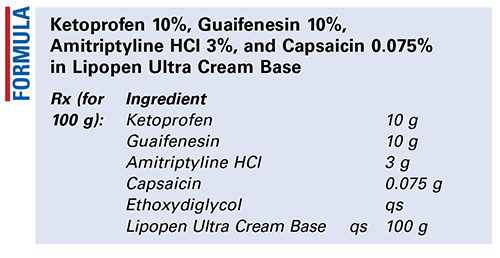US Pharm. 2019;44(3):47-48.

Method of Preparation: Calculate the quantity of each ingredient needed. Accurately weigh or measure each ingredient. Mix the powders together to obtain a uniform particle size and uniform distribution. Add sufficient ethoxydiglycol to form a smooth paste. Geometrically, incorporate the Lipopen Ultra Cream Base to final weight and mix well. Package and label.
Use: This preparation has been used in the treatment of mild-to-moderate pain.
Packaging: Package in tight, light-resistant, and child-resistant containers.
Labeling: Keep out of reach of children. Discard after ____ [time period]. For external use.
Stability: A beyond-use date of up to 30 days after the date on which it was compounded may be used for this preparation.1
Quality Control: Quality-control assessment can include theoretical weight compared with actual weight, specific gravity, active drug assay, color, texture–surface, texture–spatula spread, appearance, feel, rheologic properties, and physical observations.2
Discussion: Ketoprofen (C16H14O3, MW 254.28) occurs as a white or almost white, odorless or almost odorless, crystalline powder. It is practically insoluble in water but is freely soluble in alcohol and ether. Ketoprofen has a melting range of 92.0°C to 97.0°C. Ketoprofen has analgesic, anti-inflammatory, and antipyretic properties and is an inhibitor of cyclooxygenase. It should be preserved in tight containers.1
Guaifenesin (C10H14O4, MW 198.22) is used as an expectorant and is administered orally in the treatment of cough. It occurs as a white to slightly gray, crystalline powder that may have a slight characteristic odor and a bitter taste. Guaifenesin is soluble in water, alcohol, and propylene glycol and is sparingly soluble in glycerin.1
Amitriptyline HCl (Elavil, C20H23N.HCl, MW 313.86) is a tricyclic antidepressant that occurs as a white or practically white, odorless or practically odorless, crystalline powder or as small crystals. It is freely soluble in water, alcohol, chloroform, and methanol. Amitriptyline HCl melts at 195°C to 199°C. The pH of a 1-in-100 solution is between 5.0 and 6.0. Amitriptyline HCl should be preserved in well-closed containers. Its decomposition may be accelerated by metal ions; however, disodium edetate 0.1% significantly reduces the decomposition of these amitriptyline solutions. Sodium metabisulfite may accelerate decomposition of the drug. The metal content in amber glass may also accelerate decomposition. Decomposition can also occur when solutions in water or phosphate buffers are autoclaved in the presence of excess oxygen.1
Capsaicin (C18H27NO3, MW 305.41) occurs as an off-white powder that melts at about 65°C. It is soluble in alcohol and practically insoluble in cold water. The dried ripe fruit of Capsicum frutescens Linné, Solonaceae, contains not less than 0.5% of capsaicin. It is used as a topical analgesic in postherpetic neuralgia, diabetic neuropathy, osteoarthritis, and rheumatoid arthritis, as well as for the relief of muscular and rheumatic pain. Capsaicin should be protected from light.1,3
Ethoxydiglycol (Carbitol, Transcutol, C6H14O3, CH2OHCH2OCH2CH2OC2H5, MW 134.20) is also known as diethylene glycol monoethyl ether or diethylene glycol ethyl ether. It occurs as a colorless liquid with a mild pleasant odor. Ethoxydiglycol is hygroscopic and is miscible with water and with common organic solvents. It has a density of 1.0272 and a boiling point of 195°C to 202°C, and it is combustible. Ethoxydiglycol is nonirritating and nonpenetrating when applied to human skin, and it is used as a solvent, solubilizer, and cosurfactant.4
Lipopen Ultra Cream Base is a highly elegant transdermal vehicle specially formulated to maintain stability in the presence of high active pharmaceutical ingredient percentages, solvents, and salts and across a wide pH range. It has a smooth, luxurious feel and absorbs quickly, leaving the skin supple and nongreasy. Lipopen Ultra Cream Base occurs as a smooth white to off-white cream with a pH in the range of 5.5 to 7.5. It has a viscosity in the range of 170,000 to 250,000 cPs and a specific gravity of about 1.0.5
REFERENCES
1. U.S. Pharmacopeia/National Formulary [current revision]. Rockville, MD: U.S. Pharmacopeial Convention, Inc; February 2019.
2. Allen LV Jr. Standard operating procedure for performing physical quality assessment of ointments/creams/gels. IJPC. 1998;2:308-309.
3. Sweetman SC, ed. Martindale: The Complete Drug Reference. 36th ed. London, England: Pharmaceutical Press; 2009:32-33.
4. Ash M, Ash I. Handbook of Pharmaceutical Additives. Brookfield, VT: Gower Publishing Ltd; 1995:484.
5. Lipopen Ultra Cream Base. Product information. St Paul, MN: Fagron, Inc; December 2016.
To comment on this article, contact rdavidson@uspharmacist.com.






